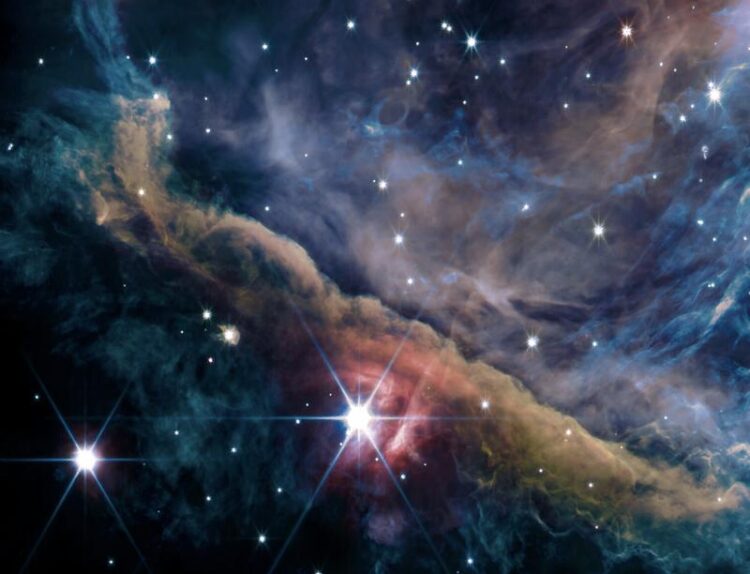Ultraviolet radiation from massive stars

Orion nebula
(c) NASA/ESA/CSA/S. Fuenmayor/PDRs4All
…shapes planetary systems.
Up to a certain point, very luminous stars can have a positive effect on the formation of planets, but from that point on the radiation they emit can cause the material in protoplanetary discs to disperse. Data from the James Webb Space Telescope provides new insights into how this affects the formation of planets in the Orion Nebula / publication in ‘Science’
To find out how planetary systems such as our Solar System form, an international research team including scientists from the University of Cologne studied a stellar nursery, the Orion Nebula, using the James Webb Space Telescope (JWST). By observing a protoplanetary disc named d203-506, they discovered the key role massive stars play in the formation of planetary systems that are less than a million years old. The study, led by Dr Olivier Berné from the National Centre for Scientific Research (CNRS) in Toulouse, was published under the title ‘A far-ultraviolet-driven photoevaporation flow observed in a protoplanetary disk’ in Science.
These stars, which are around ten times more massive, and, more importantly, 100,000 times more luminous than the Sun, expose any planets forming in such systems nearby to very intense ultraviolet radiation. Depending on the mass of the star at the centre of the planetary system, this radiation can either help planets to form, or alternatively prevent them from doing so by dispersing their matter. In the Orion Nebula, the scientists found that, due to the intense irradiation from massive stars, a Jupiter-like planet would not be able to form in the planetary system d203-506.
The team encompasses a wide range of experts from areas such as instrumentation, data reduction and modelling. The data from the JWST were combined with data collected with the Atacama Large Millimeter Array (ALMA) in order to constrain the physical conditions in the gas. The calculated rate at which the disk lost mass implies that the whole disk will evaporate faster than it would take for a giant planet to form.
“It is great that so many contributions from the team over the years, including the planning of the observations and the evaluation the data, are bearing fruit in the form of these results that represent a significant step forward in understanding the formation of planetary systems”, said Dr Yoko Okada from the University of Cologne’s Institute of Astrophysics.
The JWST data in the Orion Nebula is very rich, keeping scientists busy to conduct various detailed analyses in the fields of star- and planet-formation as well as the evolution of the interstellar medium.
Wissenschaftliche Ansprechpartner:
Dr Yoko Okada
Institute of Astrophysics
+49 221 470 1334
okada@ph1.uni-koeln.de
Originalpublikation:
https://www.science.org/doi/10.1126/science.adh2861
Weitere Informationen:
https://portal.uni-koeln.de/en/universitaet/aktuell/press-releases/single-news/u…
Media Contact
All latest news from the category: Physics and Astronomy
This area deals with the fundamental laws and building blocks of nature and how they interact, the properties and the behavior of matter, and research into space and time and their structures.
innovations-report provides in-depth reports and articles on subjects such as astrophysics, laser technologies, nuclear, quantum, particle and solid-state physics, nanotechnologies, planetary research and findings (Mars, Venus) and developments related to the Hubble Telescope.
Newest articles
Faster, more energy-efficient way to manufacture an industrially important chemical
Zirconium combined with silicon nitride enhances the conversion of propane — present in natural gas — needed to create in-demand plastic, polypropylene. Polypropylene is a common type of plastic found…

Energy planning in Ghana as a role model for the world
Improving the resilience of energy systems in the Global South. What criteria should we use to better plan for resilient energy systems? How do socio-economic, technical and climate change related…

Artificial blood vessels could improve heart bypass outcomes
Artificial blood vessels could improve heart bypass outcomes. 3D-printed blood vessels, which closely mimic the properties of human veins, could transform the treatment of cardiovascular diseases. Strong, flexible, gel-like tubes…





















